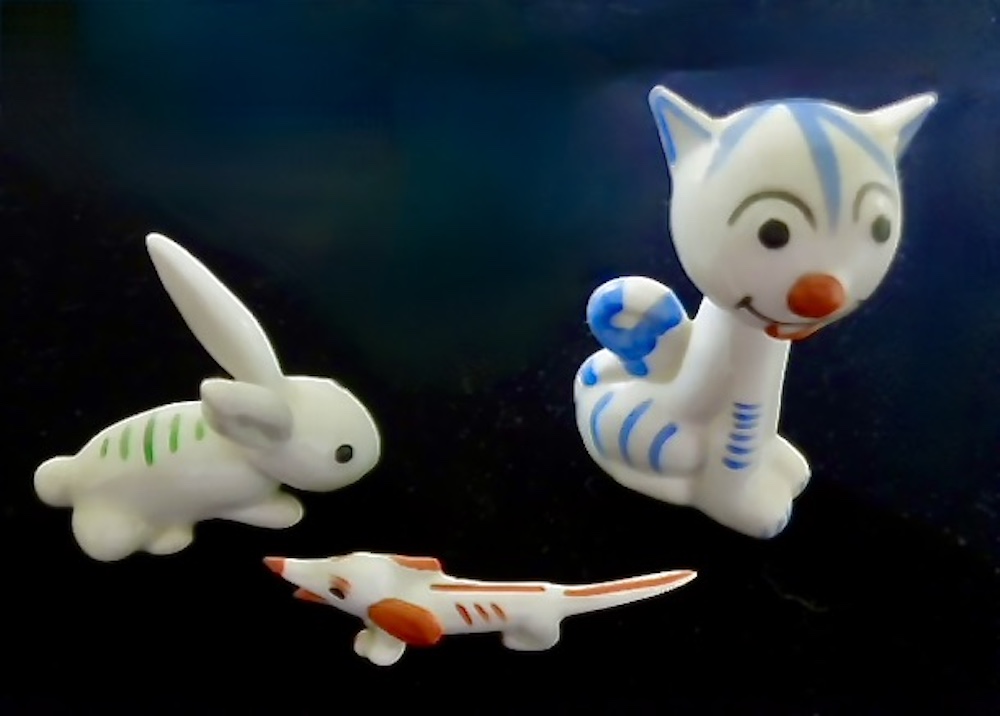November 2023
Good Eye
Collecting Miniature Porcelain Critters
by Peggy Whiteneck
When I was a kid, I collected bone china animals. These were not expensive to buy nor worth much money, but I sure did enjoy them. The adults in my family enjoyed them, too, as they could give them to me as gifts without breaking the bank!
Well, I’m a big girl now, and I still love ceramic miniatures, but now I only collect those marked at least with country of origin (usually Germany) and often with a famous maker name if it will fit on the base. Some of these are worth quite a bit more money than were items in my childhood collection.
Hagen-Renaker
An American company, Hagen-Renaker, is among the best-known manufacturers of miniature animals. Founded in 1945, it ceased operation in 2021. HRs were usually sold attached to thin cardboard labels that identified the name and retail price of the item. The labels were designed to be removed and usually were. When that happens, there is no place on the figurines to put a maker’s mark; one learns to identify them by sight. Most can still be found for less than $5 apiece on the secondary market though some rarer items go much higher. You can find the most recently made examples of HR animals on the Hagen-Renaker web site, which, as of this writing, is still up at hagenrenaker.com.
Josef Originals
This U.S. company, which operated from the mid-1940s until 1985, made mostly human forms, but it also made a few miniature animals. Perhaps the best known of these are its mice in various poses and playing with various objects. Slightly larger than Hagen-Renakers, they still can fit into miniature display spaces. Like HR, these are affordably priced.
And Then There’s Germany
Although they aren’t always marked with a manufacturer’s name, these minis are usually at least marked “Germany.” They are exceptionally well made as Germany has a long history of porcelain production.
Goebel
Best known for its post-WWII era Hummel models of children, Goebel also made animal figurines, some in miniature (of which I have a lynx, rabbit, and deer in my collection). The company was founded in 1871 and is still in production today.
Pfeffer
Pfeffer (sometimes misspelled by sellers as Pfeiffer or Pfeifer) was in production in the Thuringia region of East Germany from the late 19th century to sometime in the 1940s. It is usually marked in green or gray with either a capital P inside a capital G or a reversed F sharing a spine with a P. In my own collection, a couple of miniature polar bears were relatively expensive in 1999 at $35 each, but I found the perfect-condition sow and piglet figurine teetering on the edge of a shelf in an antique mall for just $7 the following year.

Three Art Deco-style animals
Three of the Art Deco-style animal miniatures from my little shadow box. The only one of these marked with a Metzler & Ortloff mark and probably designed by Walter Bosse is the rabbit at left. The dog and cat are done “in the style” and marked simply “Germany.” (Image courtesy of the author)
Metzler & Ortloff
Founded in 1875, this company was nationalized and its name and mark changed in 1972. Items in my own collection date from before 1972 and are marked with MO and a crown in a circle. A number of animal models were made by the artist Walter Bosse in the 1920s. Called “Groteskes,” they featured painted stripes, polka dots or other geometric accents. These Bosse grotesques usually command huge prices, even on eBay, where unattributed “Made in Germany” knock-offs of his work still pull in $35-$50 apiece.
Rosenthal
Best known for its sizeable Art Deco human figurines, Rosenthal also made some animal models, including some in diminutive size. Rosenthal was founded in Germany in 1891. The Nazi Reich stole the factory from the Rosenthal family, which was finally able to get it back in 1950. The company, which still operates under the Rosenthal name today, was purchased by the Waterford Wedgwood Group in 1997, which also acquired Hutschenreuther in year 2000. Rosenthal is among the most expensive of the German porcelains; even the miniatures can run over $100, larger figurines much higher.
Peggy Whiteneck is a writer, collector, and dealer living in East Randolph, VT. If you would like to suggest a subject that she can address in her column, email her at allwritealready2000@gmail.com.

